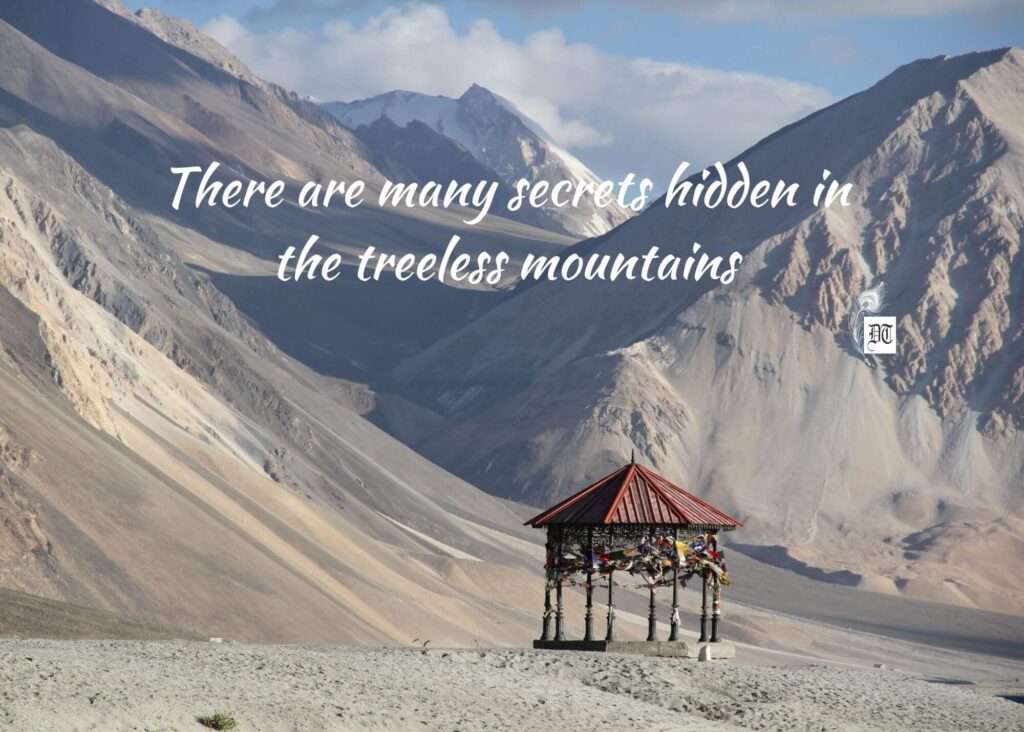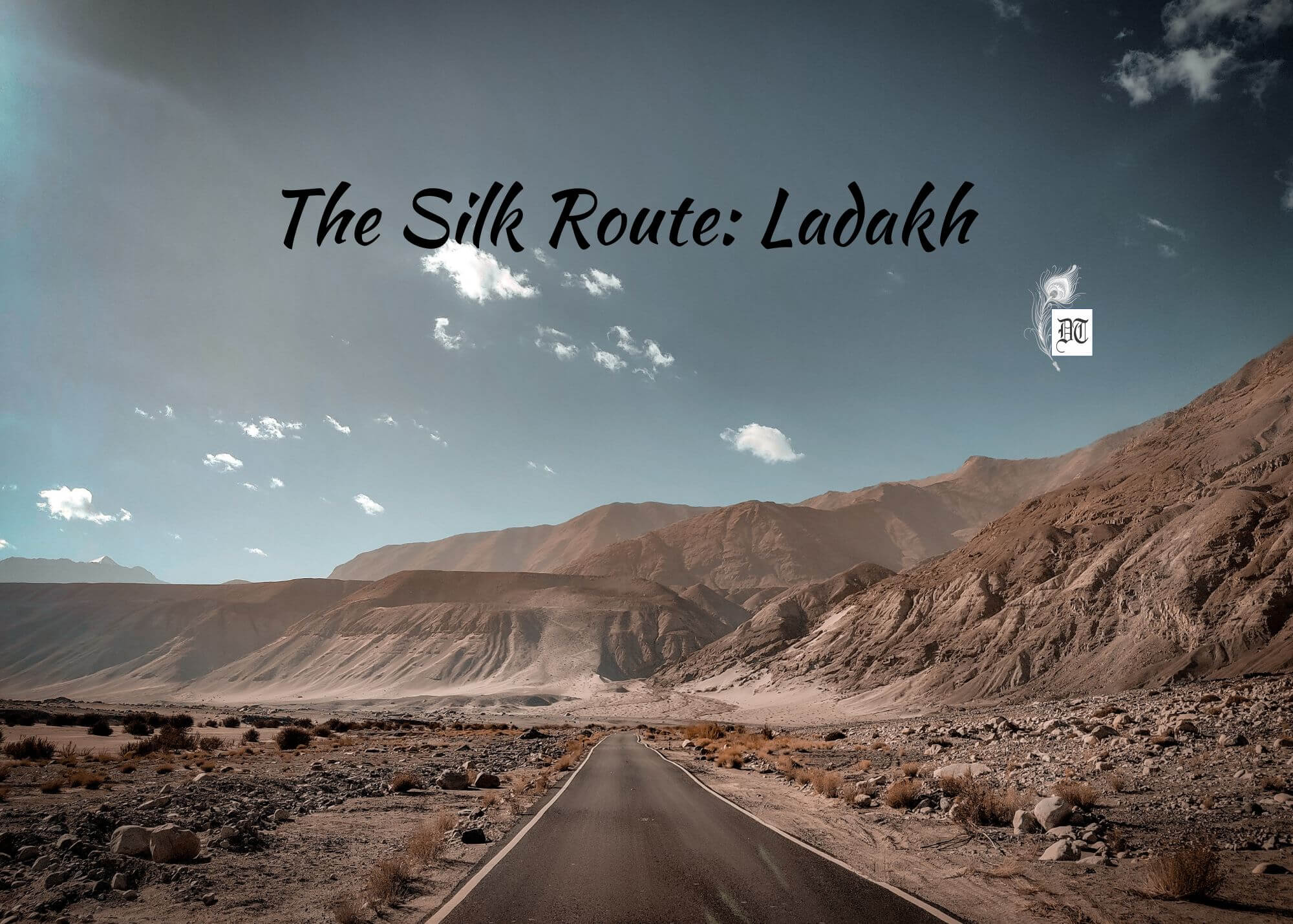Reading Time: 6 minutes
Tourists drive winding mountain roads to a breathtaking world in Ladakh. Adventurers and environmentalists visit the Silk Route trade hub, Leh. Travel with Dr Roopali to explore more – exclusively for Different Truths.

The Srinagar to Leh road takes us up through mountains and passes that are treeless, ragged, and rocky. The road crawls up the mountains, zigzagging from the valley of Kashmir, where it is forever green. Pine, apples, and the heady fragrance of cherries and peach flowers assail one’s senses. They call it Jannat (Paradise).
Once upon a time, Leh, the capital of Ladakh, was bustling with caravans and camels. It was laden with people, ideas, brocades and silks, ivory and gems, spices, and china pottery. That was a long time ago. It was then an essential part of the Silk Route.
Now, icy streams splash down the stony face of the mountains, digging deep into their entrails. Once too often, one comes across a truck or two. They were floating upside down like dead cockroaches.
It is in these inhospitable locales that the Indian Armed Forces selflessly guard the borders of the country. Day and night and night and day. This is a soldier country. The landscape is vast and bleak. Reductive and overwhelming.
En route to Kargil in Ladakh, lies Dras. Traditionally, Dras is known as Hem-babs, or “snow land”. A tourist hub for its high-altitude trekking routes and tourist sites, it is often called ‘The Gateway to Ladakh’. There is a popular claim that Dras is the second coldest inhabited place in the world. However, there is no reliable weather data to substantiate the claim.
In the late 1980s, we had stopped to lunch with the Assam Regiment stationed there.
In the late 1980s, we had stopped to lunch with the Assam Regiment stationed there. “Tagda Raho Tagda Raho” (“Stay Strong! Stay Strong”) is how the soldiers greeted us. It was the only way to survive in that bone-freezing icy cold place. It was their Regimental salutation.
I learned that this slogan is unique in the Indian Army. A former commander of the regiment would enquire about the morale of the soldiers by asking them, “Tagra Hai?” (“Are you strong/fit?”) Invariably, the answer would be “Tagra Hai Saheb” (“I am strong/fit, sir”). And the slogan salutation was born!
The Commandant was a friendly, jocular guy from Tamil Nadu. His officers belonged to different parts of India. In these inhospitable terrains, they offered us the warmth of their hospitality.
The troops, strong and fighting fit, were from various parts of the Northeast of India — an eclectic mix from Arunachal, Nagaland, Mizoram, Assam, Meghalaya, Manipur, and Tripura.
The Assam Regiment band played peppy music to keep our spirits up. One famous regimental song told the legend of Badluram – “Badluram ka badan zameen ke niche hai, par hum bhi uska ration khaata hai.” The song was written by the late Major MT Proktor and set to the tune of John Brown’s Body/The Battle Hymn of the Republic.
Indian soldiers fought in World War II on behalf of the British. During that time, each soldier was entitled to food supplies/rations.
It was the job of the Quarter Master to report the deaths of the soldiers to the authorities so that the ration for the martyred soldier could be stopped. But when Soldier Badluram was martyred, the Quarter Master forgot to report his death.
So Badluram’s rations kept coming in, resulting in a surplus for the Indian Army during the war. The story warmed our hearts and our freezing bodies.
Dras houses a memorial to our brave soldiers who lost their lives in the brutal and bitter War of Kargil fought in 1999…
Today, Dras houses a memorial to our brave soldiers who lost their lives in the brutal and bitter War of Kargil fought in 1999 – the Kargil War Memorial. We honour the Bravehearts when we work for peace.
To travel here in these parts is to hear echoes of heroic stories. We encounter the Captain’s Morh (bend), a deadly hairpin bend. Here is a small memorial to the Border Roads officer whose jeep had plunged to his death on July 27, 1954. No vehicle passes this way without stopping to pay homage. A long, precarious queue awaits its turn.
A little ahead, we are at Zoji La, a pass 1,575ft above sea level. Zoji La is a high mountain pass that connects the Kashmir Valley to its west, with the Dras and Suru Valleys to its northeast and the Indus Valley further east. A historic, victorious tank battle was fought here in 1948.
My mind zig zags too. It’s not easy to tell a travel tale. Sometimes like the curious traveller, it stops here and there. Many a time, digressing. It is not like a travel brochure.
In Kargil, a bridge built over the gushing Suru River is called the Harka Bahadur Bridge.
In Kargil, a bridge built over the gushing Suru River is called the Harka Bahadur Bridge. It commemorates the exceptional display of courage and sacrifice by Havaldar Harka Bahadur Rana. He had fought off a brutal attack to save Kargil from the marauding enemy troops in 1947.

It is the first instance of a single soldier memorial. I was filled with a sense of pride and awe. As we moved closer to Kargil, we were told of the skeleton that guards a cave-like formation. A grievously injured Major had pleaded to be left there. He promised to keep the enemy from crossing the river. Since then, no enemy has ever dared cross over.
These are narratives whispered only to the initiated. There are many secrets hidden in the challenging treeless mountains. Thomas Babbington Macaulay’s words come to mind. “To every man upon this earth/ Death cometh sooner or later;/ And how can man die better/ Than facing fearful odds, / For the ashes of his fathers, / And the temple of his gods.”
Fifteen miles from Dras lies the Draupadi Kund. A lake that has mythical connections. The folklore of Pandavas, a village on the outskirts of Dras, tells of Draupadi,the daughter of King Panchala, in the legend Mahabharata.
Legend has it that she bathed before finally ascending to the heavens in reach of the higher Himalayas. Behind it, a mountain stretches sharply into the bright blue sky. The wandering cursed Pandavas – Draupadi’s five warrior husbands – went this way, it is believed.
In Kargil and Ladakh, older women wear many strings of pearls and turquoise and amber around their necks.
In Kargil and Ladakh, older women wear many strings of pearls and turquoise and amber around their necks. It’s their wealth. The fear of the return of Zorawar Singh and his marauders who captured Ladakh still lingers. This way, they can run and hide with their wealth intact.
There is a reference to Ladakh in most of the historical records of the Silk Route. Ladakh was an important gateway in exchanging men, materials, and ideas through the ages. The capital Leh was the meeting point for traders from South Asia and Central Asia. Silk and spices and chinaware were traded in these outposts.
The spread of Buddhism through the Silk Route led to the building of monasteries and the training of lama monks for a severely austere way of life. We come across myriads of fluttering prayer flags as we travel towards Leh. Also scattered everywhere are prayer stones for the dearly departed.
The interiors of these Buddhist monasteries are supremely ornate. Gold-coloured ceilings and massive statues of the Buddha adorn the otherwise colourless spartan lives of monks. Grandeur wrought in gold and red dominate. We are nothing before the remarkable face of God.
Exquisite massive antique Thangka paintings hang from the ceilings. Rows of prayer wheels call the devout to pray.
Lamayuru, a small village between Kargil and Leh, sports a moon landscape.
Lamayuru, a small village between Kargil and Leh, sports a moon landscape. Surrealistic experiences stay put with you. The moonscape and the pristine Pangong Lake take us back millennia from when the earth was created. The famed monasteries of Lamayuru, Thikse and Hemis draw devotees and tourists from all over the world.
The emerald-green river Indus flows deep in the valley.
Around 200 km from Leh are the villages of Dha, Hanu, Garkone and Darchik on both sides of the Indus River, inhabited by the Buddhist Dard Tribes and the Brokpa people. The villages are together called the “Aryan valley”.
This is a dwindling community of 4,000 people whose lifestyle and customs are. Physical features are all different from the rest of the region. Anthropologists have visited and attempted to record their history. Not much is known about them.
The Dard Aryans have preserved their history orally, making it difficult to trace the lineage. I was fortunate to dance a slow elaborate dance with the women in their exquisite floral headdresses.
Picture design by Anumita Roy


















Written with such beauty! Riveting indeed !!! Thank you for taking me on this insightful journey across the Silk Route. The flavours of the past, the mystery and beauty of the enchanting terrain, interspersed with historical details and touching anecdotes makes it a fascinating read. You make everything come alive!!! ❤️
Beautifully written article Roopali. You made made everything come alive… The freezing cold, the brave soldiers the danger that lurked around every corner…